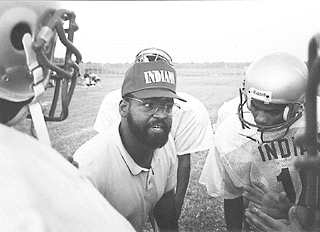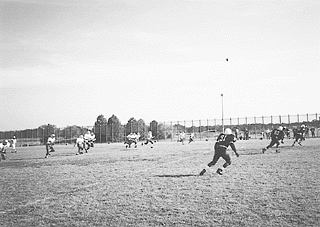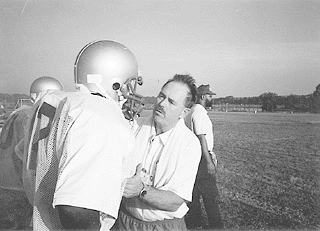https://www.austinchronicle.com/news/1997-11-07/518735/
Football Behind Bars
Field of Dreams Offers Young Offenders Second Chance
By Robert Bryce, November 7, 1997, News
|
|
There were no cheerleaders, pep squads, marching bands, or letter jackets. The teenagers in attendance weren't wearing baggy pants, fancy sneakers, or beepers. Instead, the teens -- all of them boys, all dressed in identical jeans, shirts, and plain black baseball caps -- sat in the low wooden bleachers on the north side of the field, lustily cheering for the home team, the Giddings State School Indians. If not for the dress code, the security lights, and the 12-foot-high security fence that stood along the south side of the field, it might have passed for a typical Texas high school football game. But the October 24 game between the Tornadoes of the Gainesville State Home & School and the Indians of the Giddings State Home & School was different.
It was a game played by young boys who have committed man-sized crimes. The quarterback for one team was a convicted murderer, one of the best linemen, a convicted sex offender. All of the players on the field had been convicted of violent crimes.
Giddings, which is 60 miles east of Austin, and Gainesville, which lies 65 miles north of Fort Worth, are the only youth correctional facilities in Texas -- and among only a handful of facilities nationwide -- that field athletic teams. Allowing youth offenders to play sports may seem odd at a time when teen crime is soaring. Nationwide, between 1984 and 1993, arrests of teens accused of murder or manslaughter increased by 168%. Here in Texas, the number of juvenile offenders classified as violent has more than doubled in the last seven years.
Lawmakers, eager to crack down on the surging crime problem, have passed tougher sentencing laws which allow juveniles in Texas as young as 15 to be incarcerated with adults. But while some policymakers are arguing for tougher penalties to combat the dramatic increase in juvenile crime, the two schools -- which are run by the Texas Youth Commission (TYC) -- are taking a different tack. And it seems to be working. The reincarceration rate for offenders at Giddings is nine percentage points lower than that of other youth correctional facilities in Texas. While that cannot be solely attributable to the athletics program, sports are an integral part of the school's curriculum, which includes chemical dependency treatment, academic classes, and vocational training.
Sandy Brown has been the athletic director and football coach at Giddings for 18 years. In that time, his football team has never had a losing season or an off-campus incident. Last May, the Giddings track team won the state championship in the 5A division of the Texas Association of Private and Parochial Schools (TAPPS, the 194-member private school equivalent to the University Interscholastic League). "We are trying to turn these kids around, and you can't do that unless you involve them with normal kids who are doing things well," says Brown, who attributes the team's record to the desire of his players. "If you give them the chance," he says, "they are over-anxious to prove themselves."
Brown's roster changes weekly as his athletes are released, paroled, or scheduled for court hearings. Last year, in the middle of the season, the team's starting quarterback was transferred to an adult prison. "We usually lose half the team over the course of the season," says Brown. "Two years ago at our final game, we only had 14 players." Following the example set by Giddings, Gainesville created its own athletic program five years ago and now has teams in track, baseball, football, and basketball.
Both Texas schools are members of TAPPS and both play several high-profile private high schools in Austin, San Antonio, Houston, and Dallas. Despite the visibility of their opponents, the schools' sports programs are not well known. But that obscurity could soon come to an end. Sports Illustrated has visited Giddings and is reportedly planning a feature story. But even if the schools gain a higher profile, their athletic programs appear to have solid support from Texas legislators, including Rep. Allen Hightower (D-Huntsville), the influential chair of the House Corrections Committee. During an interview last May, Hightower said he is a strong believer in "the therapeutic value of athletics." If society wants juvenile offenders to be taxpaying, responsible adults, Hightower said, then offenders have to "be put into the mainstream before you release them."
|
|
Every legislator and criminologist likes to talk about rehabilitation of youth offenders. And while some of the athletes at Giddings have gone on to success in college sports and elsewhere, others have ended up serving time in adult prisons. The stars of last year's team, Troy and Hector (not their real names) offer an example. Both stood about 5'8", weighed maybe 140 pounds, and were fiercely competitive. Both played offense and defense. Both had committed murders involving crack cocaine.
Troy played linebacker and fullback and was the team's spark plug. He was the captain and led the team in calisthenics, occasionally barking out questions like "How do we hit?" To which his teammates bellowed "Hard!" Troy dreamed of going to college. He said, "There's no justifying the things we've done. It's not right to go out and hurt other people. But I feel like giving us the chance to be able to work with other people and be successful -- that shows that this is a good program."
Hector, a shy halfback and cornerback, relied on his speed and was one of the team's chief offensive threats. "We care about how people feel about us and look at us," he said during an interview last fall. "But that motivates us to want to go out there and show people that we can do something good, that we can be something in life. I feel like I've got a better life to live than to go out there and sell drugs again and get involved in crime."
A few months ago, Hector, accompanied by Coach Brown, went before a judge in Beaumont. Despite Brown's testimony describing Hector's speaking engagements at high schools in which he served as an example to teens who might be headed for trouble, the judge sent Hector to prison in the Texas Department of Criminal Justice. It isn't known when he will be released.
Meanwhile, Troy has been released from the TYC and, while not yet pursuing his dream of going to college, he is now heading a construction crew in East Texas.
Donald (also a pseudonym) played on the football team with Troy and Hector, and he knows what happened to both of them. Raised in South Dallas, he became a gang member who sold crack. His drug of choice was marijuana soaked in embalming fluid. As a 12-year-old, Donald was involved in a rape. Nabbed by authorities four years later, he was sent to Giddings. He plays defensive end and offensive guard. "I played sports when I was in the free [world]," says Donald. "But then I got into gang-related stuff. I was selling drugs, smoking drugs, and I let that interfere with my skills."
Should he be allowed to play sports like other high school kids? "For what I've done, I deserve to go to the pen," he replied. "But I know I can change my life around. I want to receive a second chance and that's what I'm doing, trying to receive a second chance."
The October 24 game was the latest installment of a fierce rivalry between the two TYC schools. Gainesville has never beaten Giddings in football. But early on, it appeared that Giddings' dominance of the series could be at an end. Giddings fumbled on their first possession; Gainesville recovered and three plays later scored on a 25-yard run. On their second possession, Giddings gained some traction when Richard Hayes, the team's star quarterback and best athlete, scored on a 45-yard touchdown run. And just as the first quarter ended, Hayes, who took second place in the long jump during the state track meet in May with a jump of 22 feet, scored again on a 12-yard run.
But on the ensuing kickoff, Giddings' coverage broke down and the Tornadoes returned the kick 95 yards for a touchdown. By the half, Giddings was down 16-12. Three players had been ejected for fighting -- two from Gainesville, one from Giddings. As his team walked into the gym at halftime, assistant coach Lester Ward was quietly seething. A big man, Ward played football at Baylor. On this day Ward was left with most of the coaching duties because the other Giddings coach, head athletic director Sandy Brown, was ill with the flu and left the game just before the half. That left Ward in charge. Shortly after all the players were inside the gym, he quietly told them all to sit down. Then he erupted. "You don't say a word to the other people on the field," he shouted. "Do you understand?" The players shouted their response in unison. "Yes sir!"
"Do you understand?" Ward yelled. "Yes sir!" came the reply, louder this time.
"If somebody says something to you, you get up and walk away," he said.
"Do you understand?"
"Yes sir!"
"Do you understand?"
"Yes sir!"
The youth offenders at Giddings and Gainesville are allowed to play sports only if they maintain excellent behavior in their classes and group homes. Any transgressions mean suspension from the football team. Everyone on the team knows the rule, and all of them are afraid of losing their spot on the team. Some of the players have been at Giddings for four years, but have only been able to play on the football team for a year due to behavioral problems.
After Ward finished his tongue lashing, it was Stan DeGerolami's turn. DeGerolami, the superintendent at Giddings, spoke more softly than Ward, but he was no less emphatic. "I'm more concerned about behavior and discipline than I am about whether we win or not," he told the players, giving each of them a look directly in the eye. There was a long pause. The buzz of the lights in the cavernous gym seemed to get perceptibly louder. The players shifted uncomfortably. After DeGerolami's talk, Ward had the players run through a few formations and return to the field.
|
|
The second half was nothing like the first. Penalties were still plentiful, but the Giddings defense was able to stop Gainesville on every possession. Midway through the third quarter, Brown reappeared and his presence seemed to give his players a lift. In the fourth quarter, with seven minutes to go, Giddings began a drive on their own 10-yard line. For the next six minutes, the team played almost flawless, smash-mouth football. With less than two minutes to go, they scored, and converted the two-point attempt to go up 20-16. The stands, filled with about 200 people, most of them students from Giddings, were suddenly joyous.
The game wasn't over, though. After a short kick, Gainesville was at midfield with a little over a minute to play. Aided by a penalty, they reached the Giddings 35-yard line. With about 30 seconds left, Gainesville tried a pass play and had a man wide open in the end zone. But the receiver dropped the ball, and on the last play of the game, Giddings defensive end Donald, the sex offender, sacked the Gainesville quarterback and time expired.
The two teams lined up at midfield to shake hands. The Gainesville player who had dropped the touchdown pass was near tears, and his teammates looked nearly as dejected as he was. The players from Giddings, meanwhile, were ebullient. They had salvaged a victory on their home field against their biggest rival. They had turned the second half into a second chance and they had made the most of it.
After the game, Hayes, who committed a crack-related murder in South Dallas at the age of 14, was eager to talk about second chances. Hayes was a member of the Tre Five Sevens, a gang that was affiliated with the Crips. He lived in a neighborhood where he frequently saw "people getting killed, people getting shot, selling drugs. I was easily misled," says Hayes. "I was the type that wanted a fancy car. I wanted what they had." But now, after four years at Giddings, he wants something different. He wants to go to college. "I feel like I can change," says Hayes, who will turn 19 shortly before Christmas. "I was still young then. I deserve a second chance."
Hayes quickly interrupts himself. "Wait, I don't want to say I deserve it," he says. "I need, I need a second chance."
Copyright © 2024 Austin Chronicle Corporation. All rights reserved.



